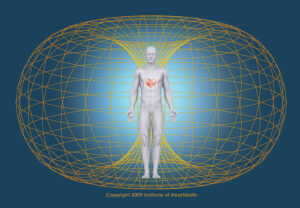Electromagnetic fields (EMF) are a constant presence in modern life, surrounding us in forms both visible and invisible, from natural sources like sunlight to man-made emissions from mobile phones, Wi-Fi routers, and other electronic devices. As athletes push the boundaries of physical performance, optimizing cardiovascular function is critical. However, one area of emerging concern is the potential impact of EMF radiation on heart health. In this article, we will explore how EMF radiation may affect heart rate variability, arrhythmias, and overall cardiovascular performance, with a particular focus on athletes.
Understanding EMF Radiation
EMF radiation refers to the energy emitted by electrical and magnetic sources, which can either be ionizing or non-ionizing. Ionizing radiation, such as X-rays, can remove electrons from atoms, posing serious health risks such as cancer. Non-ionizing radiation, emitted by devices like cell phones, laptops, and Wi-Fi routers, doesn’t have enough energy to ionize atoms but can still affect biological systems. Although the focus of this article is on non-ionizing radiation, the long-term effects of consistent exposure are still a growing area of research. For athletes who train and compete under constant exposure to electronic devices, understanding the potential implications is essential for both performance and health.
The Heart: The Most Powerful Electromagnetic Organ
The HeartMath Institute has been at the forefront of studying the heart’s electromagnetic field and its role in human health and performance. According to their research, the heart’s electromagnetic field is 60 times greater in amplitude than that of the brain, and its magnetic component is more than 100 times stronger. This field can be detected up to several feet away from the body, radiating in all directions.
Heart-Brain Communication and the Earth’s Magnetic Field

The heart’s electromagnetic field plays a crucial role in communicating with the brain and the rest of the body. HeartMath research demonstrates that the heart sends more signals to the brain than the brain sends to the heart, affecting emotional processing, decision-making, and stress responses. This process, called heart-brain coherence, is essential for optimal human performance. When in a state of coherence, the heart and brain operate in sync, leading to improved cognitive function, emotional stability, and physical health.
What’s even more fascinating is the potential for the heart’s electromagnetic field to interact with the Earth’s magnetic field. Studies from the HeartMath Institute suggest that the Earth’s magnetic field can affect the rhythms of the human heart and vice versa. This phenomenon forms the basis of their Global Coherence Initiative, which examines how shifts in the Earth’s magnetic environment may influence human health and behavior.
Given the heart’s natural electromagnetic power and its sensitive interaction with both the brain and the Earth’s magnetic field, it is worth considering the potential impact of artificial EMF exposure on heart function.
The Connection Between EMF and Heart Rate Variability (HRV)
Heart rate variability (HRV) is a measure of the variation in time between each heartbeat. It’s often used as a key indicator of cardiovascular health and the body’s ability to adapt to stress. Higher HRV indicates better adaptability and a more robust autonomic nervous system (ANS), while lower HRV is associated with increased stress, poor recovery, and heightened risk for cardiovascular issues.
Studies have shown that EMF radiation, particularly from mobile phones and Wi-Fi routers, may reduce HRV. For athletes, a lower HRV can signify that the body is under stress and not recovering properly between workouts. This can be a hidden factor that slows down progress, affects endurance, and increases the risk of injury.
How EMF Radiation Disrupts HRV
EMF radiation may disrupt HRV through its effects on the autonomic nervous system. The ANS, responsible for regulating involuntary bodily functions like heartbeat and digestion, has two branches: the sympathetic (fight or flight) and parasympathetic (rest and digest) nervous systems. Ideally, these two branches work in harmony, adapting to different situations, such as intense exercise or rest periods.
Exposure to EMF has been shown to increase the activity of the sympathetic nervous system, causing a “fight or flight” response even in the absence of immediate danger. This chronic activation of the sympathetic system can lead to a reduction in HRV, placing added strain on the heart. Athletes may experience this as an inability to recover properly from training or competition, lower energy levels, and decreased athletic performance.
Example: Wi-Fi Exposure and HRV
A study published in the Journal of Pharmaceutical Research International explored the effects of Wi-Fi exposure on HRV. The researchers found that individuals exposed to Wi-Fi signals for extended periods had reduced HRV, indicating an increased risk of cardiovascular stress. While this study focused on the general population, athletes—who rely on their cardiovascular systems for peak performance—may be even more susceptible to the detrimental effects of EMF on HRV.
For athletes using wearable technology, Bluetooth devices, and spending long hours near Wi-Fi routers, this is an area that deserves careful consideration. Keeping HRV optimized is crucial for proper recovery, endurance, and overall performance.
EMF Radiation and Arrhythmias: A Growing Concern
Arrhythmias, or irregular heartbeats, are another potential cardiovascular issue linked to EMF exposure. Arrhythmias can range from harmless extra beats to life-threatening conditions like atrial fibrillation (AFib), where the heart beats irregularly and inefficiently.
The heart relies on an intricate electrical system to maintain a regular rhythm. Specialized cells within the heart generate electrical impulses that travel through the heart muscles, coordinating its pumping action. Concerns have been raised about whether EMF radiation, particularly from high-frequency sources like mobile phones, might interfere with these electrical signals, potentially leading to arrhythmias.
Athletes are already at risk for arrhythmias due to the strain that intense exercise places on the heart. Studies have shown that endurance athletes, in particular, are more prone to developing atrial fibrillation due to repetitive stress on the heart over time. Adding EMF radiation from smartwatches and fitness trackers into the mix may exacerbate this risk.
Cardiovascular Performance and EMF Exposure: The Bigger Picture
Cardiovascular performance—the ability of the heart and lungs to supply oxygen to muscles during prolonged physical activity—is the cornerstone of athletic endurance. Even subtle disruptions to heart function can impair an athlete’s ability to perform at their best. EMF radiation’s effects on HRV, arrhythmias, and the overall nervous system could, over time, negatively influence cardiovascular performance.
EMF and Inflammation
One of the most significant ways that EMF exposure may impact cardiovascular performance is through its connection to inflammation. Chronic low-grade inflammation is a major contributor to cardiovascular disease and poor recovery. EMF exposure induces oxidative stress, which can lead to inflammation throughout the body, including the heart and blood vessels.
For athletes, chronic inflammation not only impairs cardiovascular function but also contributes to slower recovery times, increased muscle soreness, and an elevated risk of injury. This is particularly relevant for endurance athletes who already place significant stress on their bodies.
Reduced Recovery and Fatigue
Increased EMF exposure may also contribute to reduced recovery times and greater fatigue. Athletes often rely on rest days and sleep to recover fully from intense training sessions, but research suggests that EMF radiation can negatively affect sleep quality and duration. This can be particularly detrimental to cardiovascular recovery, as sleep is when the heart and body perform most of their repair processes.
A study in the Journal of Clinical Sleep Medicine found that exposure to high levels of EMF radiation, such as sleeping near Wi-Fi routers or using electronic devices in bed, was linked to reduced sleep quality and increased fatigue. For athletes who depend on optimal sleep to recover, reducing EMF exposure during rest periods may enhance recovery and cardiovascular performance.
Mitigating the Impact of EMF on Cardiovascular Health
As research continues to explore the connection between EMF radiation and heart health, athletes can take proactive steps to minimize their exposure and protect their cardiovascular system.
Practical Tips for Athletes
Limit Device Usage: Reducing the amount of time spent near high-EMF devices like mobile phones, tablets, and Wi-Fi routers can significantly lower exposure levels. Consider placing devices in airplane mode when not in use, especially during sleep and recovery periods.

Save 25% on Aires Tech EMF protection with code “MOL” Use EMF Protection Devices: Aires Tech has developed innovative solutions designed to cancel the impact of electromagnetic radiation on the body, making it a practical choice for athletes concerned about cardiovascular health. Their technology is based on the use of silicon resonators that interact with electromagnetic fields, reshaping and harmonizing the radiation before it reaches the body. This helps minimize the potential biological effects of EMF exposure, including those related to heart health.
Optimize Recovery: Athletes should focus on optimizing their recovery through proper sleep, hydration, and nutrition. Using blue-light-blocking glasses before bed, creating an EMF-free sleeping environment, and incorporating antioxidants (such as vitamin C and glutathione) can all help mitigate the effects of EMF-induced oxidative stress on the heart and body.
Grounding or Earthing: Grounding, or spending time barefoot on the earth, has been shown to reduce inflammation and improve HRV. This practice may counteract some of the negative effects of EMF exposure on the cardiovascular system by helping the body balance its electrical charge.
Maintain Proper Distance from Devices: Athletes should avoid carrying their phones or electronic devices close to their bodies for prolonged periods. For example, placing a phone in a gym bag or backpack rather than a pocket can help reduce direct exposure to EMF radiation near the heart.
Prioritize HRV Tracking: Wearable devices that measure HRV can be valuable tools for athletes, but it’s essential to use them mindfully. Consider devices that emit low or no EMF, and avoid wearing them continuously to minimize exposure.
Final Thoughts: Protecting Heart Health in an EMF-Saturated World
While more research is needed to fully understand the long-term effects of EMF radiation on cardiovascular health, the current evidence suggests that athletes should take proactive steps to limit their exposure. From reducing the use of EMF-emitting devices to utilizing protective technologies like those offered by Aires Tech, there are many practical ways to safeguard heart health.
Athletes put immense strain on their cardiovascular systems, making it even more critical to minimize any potential external stressors, including EMF radiation. By staying informed and making conscious choices, athletes can continue to push their performance while protecting their most vital organ—the heart.
In a world where EMF exposure is nearly impossible to avoid, taking small, consistent actions can go a long way in ensuring long-term cardiovascular health and peak athletic performance.








